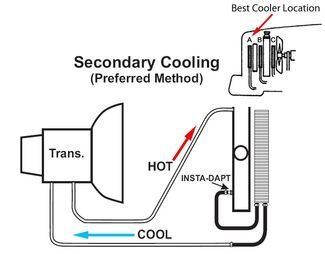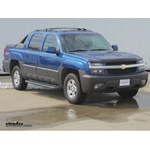
Installing Derale Transmission Cooler # D13504 and Derale Snap-In Radiator Adapter Fitting # D13035
Question:
I plan on installing the Derale trans cooler #13504 on my 1998 Chevy Silverado C1500 w/ 5.0 liter motor and 2 WD. Earlier you guys recommended using the the D13035 fitting for this install. I have a few of questions re: this installation. 1. Im confused as to where the D13035 fitting connects. Does the fitting connect into the radiator? 2. If the D13035 fitting plugs into the radiator, doesnt that mean I will have to cut and connect into the factory return line, flair the tubing and connect the Derale return hose to get the cooled fluid back into the trans? 3. On my truck the tubing for the factory transmission cooler is located on the passenger side of the radiator. One line connects at the top of the radiator, the other connects at the bottom of the radiator. Can you tell me which is the in from trans line hot fluid and which is the return to trans line cooled fluid? Thanks for your help!
asked by: Bob N
Expert Reply:
When installing the Derale Transmission Cooler, # D13504, the Derale Snap-In Radiator Adapter Fitting, # D13035, will connect to the transmission return line from the radiator. To determine which is the cool side, start your vehicle and put it in gear with your foot on the brake. Run the engine to about 2000 RPM for about a minute and then turn off your truck. Touch the lines running from the radiator to the transmission to find the cooler of the two. One you have located the cool side, remove this line from the radiator and install the Derale Snap-In Radiator Adaptor, part number # D13035, into the radiator. To do this, cut the transmission cooler hose to length, slide a new clamp over the hose, and slide the adapter into the hose. The adapter can now installed into the radiator. The final step is to take the line that was originally removed from the radiator and attach it to the remaining new hose from the cooler with a clamp. No cutting into the factory return line or flaring of hoses needed.
I have attached a video which shows this process in detail.

Products Referenced in This Question
Derale Series 8000 Plate-Fin Transmission Cooler Kit w/Barb Inlets - Class IV - Efficient
- Transmission Coolers
- Plate-Fin Cooler
- Full-Size Truck
- SUV
- Standard Mount
- 11W x 12T x 7/8D Inch
- With 11/32 Inch Hose Barb Inlets
- Derale
more information >
Product Page this Question was Asked From
Derale Snap-In Radiator Adapter Fitting for GM
- Accessories and Parts
- Transmission Coolers
- Radiator Adapters
- Derale
more information >
Featured Help Information
Instructions
Miscellaneous Media

Continue Researching
- Q&A: Replacement Ramp Door Spring Kit for 85 lb Horse Trailer Door
- Article: Frequently Asked Questions About Transmission Coolers
- Article: Brake Controller Installation: Starting from Scratch
- Article: Transmission Cooler
- Q&A: Transmission Cooler Recommendation for a 2004 Chevy Silverado 2500HD with 6.0 Towing a 5th Wheel
- Article: Brake Controller 7- and 4-Way Installation Kit (ETBC7)
- Article: Trailer Wiring Diagrams
- Q&A: Recommended Transmission Cooler for 2008 Chevrolet Tahoe
- Q&A: Is Draw-Tite Hitch Compatible With 1Up Super Duty Bike Rack on 2024 Outback Wilderness
- Q&A: Transmission Cooler Recommendation for 2011 Chevy Silverado
- Q&A: What is the Difference Between a 4-Way and 7-Way Trailer Connector
- Q&A: Recommended Towing Components for 2015 to 2017 Chevy Traverse
- Article: RV Roof Types: What Type of Roof Does My RV Have?
- Article: Wiring Trailer Lights with a 7-Way Plug (It's Easier Than You Think)







